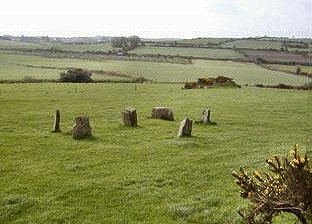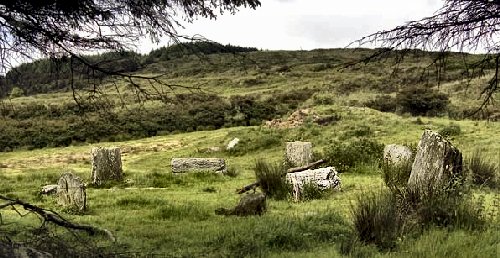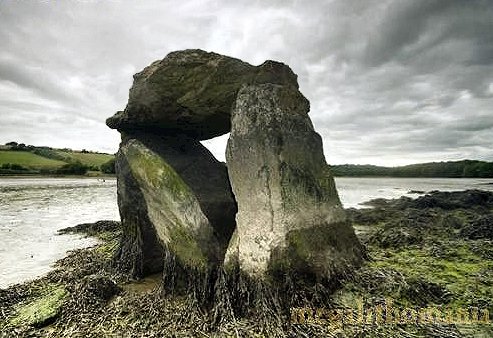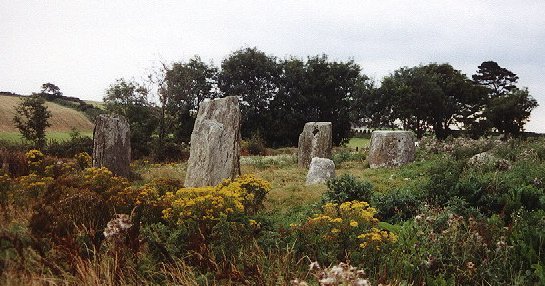county list
|
Turn smartphone to horizontal
view. SELECTED SITES IN part two Place-names in italics refer to listed entries. |
|
Glantane
East: Wedge-tomb and Stone Circles Visible to the W of a by-road running N and skirting a forestry plantation, this neat little wedge-tomb (known locally as "The Flags") stands 90 cm high in a field, and has a capstone 2.4 metres square, resting on two sidestones and a back-stone. Some of the double-walling survives, and a small stone 40 cm high splits the entrance between the two side-stones. Although a National Monument, access has been made difficult with barbed wire.
~ Barbed wire also festoons the fence into the next field (to the NW) where there is a stone circle almost 5 metres in diameter, five of whose stones are still standing and six have fallen, some into the surrounding ditch, at least part of which is faced with stone. There are two outliers to the N and S sides, 4 metres tall and recently re-erected - but one has fallen again ! In the middle of the circle is a large hole, where presumably a boulder or boulder-burial stood until recently. As with most stone circles, the site commands a fine prospect. It is one of a group of circles with ditch and bank which include Reanascreena South, as well as Lissyviggeen in Kerry. ~ 400 metres SSW, W of the lower road, beside a derelict (maybe now rebuilt) house, up a grassy lane bounded on the N side of spruce-trees, and itself surrounded by trees, in the same townland (W 280 833) is an axial stone circle, 4.7 metres in diameter, of ten stones and a loose flagstone lying beyond the axial stone. The portals opposite the axial are 81 cm high. ~ On the opposite
side of the lower road, some 800 metres SSW of the wedge-tomb
is an alignment of three stones, one being 2.4 metres high
and the other two (broken) surviving to a height of 90 cm. ~ 3.2 km NNE is a five-stone circle (three stones undisturbed) with outliers and a radial cairn (similar to the Kealkil complex) at Knocknakilla (W 297 843). The circle has good portal-stones. One of the outliers (over 4 metres long) to the SW of the circle has fallen, but another, though leaning, stands 4 metres high. There are other circles in the townland. Within sight, in Millstreet Country Park, is the 'complex' of Cloghboola Beg.
~ Just over 1 km SE is a five-stone circle at Carriganimmy (W 293 827). ~ 4 km S are Cabragh stone-rows and five-stone circle (W 278 798). Gowlane
North: Stone Circle 1.7 km S by W of Beenalaght alignment and 3.2 km N of Donoughmore, 400 metres W of the road and at the bottom of the second field NW from a pair of field gates is a perfect circle, 7 metres in diameter. It comprises eight stones (two fallen) averaging one metre in height, two of which, only 90 cm apart, form an entrance to the N with another pair set radially outside the circle, slightly farther apart. This entrance passage, 2.1 metres long, faces a large axial stone: a rectangular slab 150 by 90 cm on the opposite side of the circle. One of the entrance stones has been broken since I first visited the circle in the late nineteen-seventies, and it now seems to be used (with the usual Irish disrespect for antiquities and landscape) as a place to dump large stones dug up by destructive modern machinery. Greenhill:
Ogam Stones 8 km SSE of Mallow,
and about 300 metres S of a by-road, by a hedge on the W side
of a field is a large fragment of an irregular block on which
the clear inscription CATTUBUTTAS MAQ. . .
survives. About 40 metres further, on the other side of the
hedge and bank is a fine, large, tapering stone 2.4 metres
high, on which is the inscription TRENU MAQI
MUCOI QRITTI, together with deep grooves above and
below the N, and other grooves made recently by vandals. Quartz
pebbles abound nearby. ~ 5.6 km SW, 9.6 km S by W of Mallow, almost opposite the ruins of a church, and about 10 metres N of a by-road, in Kilquhane, is a holed stone, now prostrate, 1.80 metres long, 70 cm wide and 25 cm on its thick side. Near the thin edge of the stone, 73 cm from the near end and 56 cm from the thick edge, is an irregular hole from 6.2 to 11.3 cm across, and of a depth varying from 5 to 19 cm. This stone, known as "The Sinners' Stone" (Cloch na pecaib), was resorted to by pregnant women, who pulled pieces of cloth through the hole to ensure easy (or at least safe) delivery. ~ Another holed stone is at Lackendarragh, 7.2 km WNW of Kilquhane (see under Garrane in part one). ~ 2.4 km SE of the Greenhill Ogam stones is the fine wedge-tomb at Island. Gurranes:
Stone-row click
on the thumbnail for a larger picture 1.2 km NW of Castletownshend, visible on a ridge to the N of theroad to Skibbereen, on the opposite side of the road to Knockdrum fort, three slender pillars (up to 4.2 metres high), known as 'The Three Fingers', rise dramatically against the sky, evenly spaced and set into joints in the exposed rock surface. A fourth stone lies prostrate nearby, out of line. A fifth stone was removed in the 19th century and now stands in the Somerville Estate at Castletownshend. ~ 17.7 km NW are the petroglyphs at Ballybane. Island:
Wedge-tomb 8.8 km SSE of Mallow and 1.2 km E of Burnfort, to the W of a by-road, approached up a lane and through a depressingly-squalid farmyard, this fine example of a small wedge-tomb was excavated in 1957. The gallery, 6 metres long, and facing SW, is a single chamber, bounded by typical double wall of stones. Parallel to the gallery is the heel-shaped kerb which connects with the flat façade of the tomb. The thin roof-stones are in situ, and much of the cairn material survives between the gallery and the kerb. Kealkil:
Stone Circle, Standing Stones and Cairn click
on the thumbnail for larger pictures This impressive and splendidly-situated monument is 800 metres SE of Kealkill village and about 180 metres NE of a sharp bend on a steep by-road, from where the tops of the standing stones are just visible. Overlooking Bantry Bay and Kealkill village, it comprises a fine 5-stone axial circle of large stones, with 2 outlying monoliths, the higher of which is now almost 4 metres high. It was originally over 6 metres high. This is one of the few circle sites to have been excavated, and inside the circle was found a setting of crossed timber sleepers which may perhaps have held an upright of wood or stone. Like most stone-rows, the two outliers are on a NE-SW axis, parallel with that of the circle and aligned on a notch in the hills opposite. Nearby also is a small cairn of stones incorporating a circle of small upright stones set radially (see also Knockraheen under Scrahanard). ~ Just over 400 metres
SW of The Kealkil monuments, in the third field on the opposite
side of the road, in Breeny More (W 050 552) are the
remains of a large multiple-stone circle enclosing four boulder-burials
set in the form of a rectangle. All four of their large capstones
are very equal in size and shape and the 'artistic ensemble'
is beautiful. ~ 2 km SSW is a five-stone circle nestling against the south side of a wall in Derryarkane (W 052 537). Two large thorn trees are growing on the south side of the stones (all about 1.2 metres high) make it even harder to detect in the landscape. One of the portal stones has fallen. The entrance and the almost-square axial stone to the SW are aligned with a notch in the distant hills. ~ 5 km ENE is one of two stone circles in Maughanaclea (W 104 565), easily accessible by a farm-lane. With good views to the N, it is over 10 metres in diameter and contains two boulder-burials. Twelve of the original 13 stones survive, six of them fallen. The axial stone is, as usual, long and low. 1.5 km E by S of the first circle (W 090 563) immediately W of a tarred track is a five-stone circle with an outlier 2.4 metres high. ~ 2 km ESE in Ardrah (W 069 544) is an alignment of 4 stones, one of which is 2 metres high. ~ 3 km NNW, conveniently beside a by-road in Maughanasilly (W 044 585) and overlooking Lough Atooreen is a fine but uneven row of six stones including two massive blocks (one of them rectangular with a perfectly flat top), and two fine slabs with perfectly-horizontal upper edges. ~ 6.5 km N by W, also by the roadside in Derrynafinchin (W 047 622) is an overgrown circle with a large quartz boulder in the centre. A fallen orthostat has a large cup-mark carved into it, and, next to the axial stone is an altar-like structure which could be an ancient addition - or date from Penal times and thus be one of the few surviving "mass-rocks" at a site sacred to at least one older cult. Another large stone within the circle may be a boulder-burial. ~7.8 km SSW of Kealkil
and only 4 km E by S of Bantry is a perfect five-stone circle
at Trawlebane (W 042 470) swamped by brambles in 2003,
and only 1.8 metres in diameter. ~ 7.2 km W by N of Kealkil are the boulder-burials, standing stones, and stone circle at Mill Little. ~ 10.3 km ESE of Kealkil at Cullenagh (W 151 519) is an intact but overgrown five-stone circle close to a by-road. ~ 11.5 km ESE in Clodagh (W 153 500) is a compact little circle of seven stones (or nine: two stones may have broken in two) just 30 metres above a by-road. The stones (including a very low axial) form a complete ring, so there is no proper entrance. Small quartz pebbles sit on top of the stones that are still standing upright. To the SW, parallel to the axis of the stone circle, are a pair of outlying stones that are of similar height to those of the circle - no taller than 1 metre. Keamcorravooly:
Wedge-tomb 75 metres S of a by-road, opposite a small plantation of spruce trees on either side of the road, some 11.2 km SSW of Ballyvourney and 800 metres WSW of the Bansheelin river, "The Giant's Grave", (An Uaigh an Fhathaigh), is a neat and picturesque tomb about 3.6 m long, with two overlapping roof-slabs, the easternmost of which is supported by a small chocking-stone on top of the backstone. It is markedly wedge-shaped, and retains much of its double-walling. Like most of the Cork wedge-tombs it is low, the entrance being about 106 cm high. It commands a fine view of the hills to the N and W. About 200 metres further up the hill, on a ridge, is a second, ruined, wedge-tomb. The large field in which they stand has been planted with forest which probably now hides the tombs. ~
1.5 km N in Gorteenakilla (or Gurteenakilla,
W 143 693) is 'The Great Stone' supposed to have
been thrown by one giant at another. My colleague Tom FourWinds
reports that the owner of the land was known locally for
not caring about old stones. When he walked into the pub
one night and said it had fallen over and broken in two,
his neighbours assumed that it had gone forever. ~
5.3 km ESE in Turnaspidogy (W 189 666) is an alignment
of three stones around 2 metres high, one of which has fallen.
They are set on a little flat shelf on the side of a gentle
slope. Modern farming and hedgerows have removed hints as
to why this spot was chosen. Kilmaclenine:
Megalithic Tomb Known as 'Acuthogue', and situated 4.8 km SW of Buttevant and 1.2 km ENE of Kilmaclenine Crossroads, on the left hand side of a lane leading NNW from a by-road, this box-like tomb (an enormous kist ?) was opened in the last century and found to contain 'a skeleton, a sword and some beads'. The roofstone is over 2.75 metres long, supported on two sidestones and a backstone over 1.5 metres high. The tomb is aligned E-W. To add to its oddness, it seems to be set into a massive mound that has been mutilated over the millennia, now having the appearance of grass-covered sand dunes.
Knockanevin - see under Labbamolaga. Knockdrum:
Stone Fort, Souterrain, and Cross-pillar 1.2 km W of Castletownshend, on the S side of the road, opposite Gurranes stone-row, approached by a path and steps, this fort was restored in the last century and encloses an area 22 metres across. In the middle is a roofless square stone hut, from one corner of which a 3-chambered lintel-roofed souterrain runs through hewn rock. Just inside the entrance to the fort is a cross-pillar (presumably found nearby and erected here by the restorers). Recently moved to just outside the entrance, and probably not directly connected with the fort, is a large boulder bearing about 40 cup-marks, with a few associated grooves and rings, dating from the Bronze Age. On the right hand side of the entrance passage is a small guard-chamber. The very thick cashel walls stand some 1.7 metres high. ~17.7 km NW are the petroglyphs at Ballybane. Knocknagoun:
Wedge-tomb 10.4 km NNW of Coachford and 2 km N of Sheskinny Cross, 60m E of a track, a quaint, low tomb, with a gallery about 2.1 metres long, closed at the E end, is covered by 2 capstones. The larger (2 metres long) overlaps the smaller, and they rest on 6 sidestones and a backstone. Round about is some evidence of a cairn. Up to the end of the last century it was completely covered by cairn stones. Attempts to destroy the sepulchre led to several misfortunes, and only the cairn and most of the outer walling have been removed. Knocknaneirk:
Stone circles The more northerly of the two is a fine five-stone circle, 5 metres in diameter, whose taller stones stand some 1.6 metres high. One of them has beautiful solution pits in the top and strange axe-shaped hollows on its flank. The altar-shaped recumbent is 1.5 metres long and 1.1 metres high. 500 metres south of it (W 371 627) is a much larger, but ruined circle, 15 metres in diameter and scandalously unprotected from cattle, with stones of 1.3 to 1.5 metres tall surviving mainly on the North side. ~ Just under 4 km ENE in Currabeha (W 412 640) is a circle of many small stones, 8 metres in diameter and with a quartz boulder in the centre. Its axial-stone is 1.3 metres long and 8 cms high. 400 metres NW (411 644) in the same townland is another more ruined multiple-stone circle of similar diameter, but with a quartz boulder on its circumference, and an outlier some 40 metres NE. The site commands fine views. ~ 2.7 km NNW in Clearagh (W 363 652) is a rock 3 metres long with cup-marks and faint but impressive parallel lines, grooves and double rings. ~ 3.5 km NW in Barnadivane (W 338 643) is a fine pair of quartz standing-stones, 1.3 metres high. ~ 5 km NW in Rossnakilla (W 3245 657) is an alignment some 6 metres long, whose tallest stone (at the E end) stands 2 metres high. 50 metres NE is another stone, slab-shaped. ~ 8.5 km W by N, on a ridge in Knockaunnagorp (W 287 637) is a beautiful standing-stone some 2 metres high, dressed on three of its four sides. ~ Just over 5 km W by S in Reanacaheragh (W 318 627) is a boulder-burial which looks 'just like a dolmen that shrunk in the rain'. A large boulder (with solution pits on the top) covers a small stone-lined chamber, the whole surrounded by a small kerb. ~11.5 km WSW is
a fine stone circle at Gortroe (W 259 605) containing
a boulder-burial
and with a quartz
outlier. Labbacallee:
Wedge-tomb 2 km SE of Glanworth and 8 km NW of Fermoy, by the roadside, over a wall, this is the largest of Irish wedge-tombs. Three huge capstones (the largest being nearly 8 metres long and weighing 10 tonnes) slope downwards towards the back. The gallery consists of a large rectangular chamber, with a small one behind it, separated by a dividing slab, one corner of which has been trimmed off to leave a 'half-porthole'. The gallery is triple-walled, and buttressed at the back by 3 slabs set parallel with the tomb's axis. In front of the gallery are the remains of a large rectangular, unroofed portico or antechamber, wider than the gallery and cut off from it by a large slab. It is one of many tombs — especially wedge-tombs — to be (latterly) associated with the Celtic Hag-goddess also known as Caillech Bhéarra: Labbacallee (Leaba Caillighe) means "Hag's Bed". Other tombs are associated with the lovers Dermot and Grania in the folk tradition. The sepulchre resembles a French gallery-tomb in size and design, a similarity shared by the wedge-tomb at Burren, Cavan. ~
Just over 3 km WNW of Labbacallee in Moneen (R 746
028) is a ring-barrow within which was built a Bronze Age
multiple-kist cairn. There is a curiously smooth stone in
the S corner. A food-vessel burial and an urn burial were
later added outside the fosse.
~ Just 2 km NW of Glanworth in Ballylegan (R 745 054) is a fine (though leaning) standing-stone well over 3 metres tall, situated some 500 metres (3 fields) from a minor road. One side of it is split, and weathered at the top.. ~
About 4 km N by E is the bullaun-stone at Killeenemer
(see under Labbamolaga, below). Labbamolaga
(Labbamologga) Middle: Standing-stones or circle, and 'cursing-stones' In a field close
to a by-road in the townland of Knockanevin are four
stones (one broken) about 1.5 metres high forming a rectangle
5 metres by 1.5 metres which has suggested to some that it
is one of the few Scottish-style "four-poster" circles
in Ireland. (See also Lettergorman, below.) If so,
it is unusually large. An early 19th century report puts the
number at 5, while locals at the same time averred that there
had been 8. The only indisputable four-stone circle in Ireland
is in county Down at Mullaghmore
(see under Tamnaharry). ~ 9.5 km NW of Labbamolaga, and in county Limerick, is Ballyriggin Standing-stone (R 695 240), of curious shape and close by a lovely stream. It is approached down a track that is used by the Kilfinnane Outdoor Pursuits Centre. ~ In a field close to a by-road about 11 km S by E at Killeenemer (R 776 067) there is a boulder with three very large bullauns up to 30 cm in diameter. Lettergorman:
Stone Circles Less than 800 metres SE of Lough Atariff, about 50 metres S of a narrow by-road, this somewhat mournful 5-stone circle is just under 3 metres in diameter with stones up to 1.5 metres high, the axial stone being 1.4 metres high and a little longer. One portal stone has fallen, as has a large quartz monolith: an outlier that would have occupied a position along the axis in the direction of Carrigfadda hill to the SW. This circle is referred to either as Lettergorman S, or Lettergorman SW. ~ A likely "four-poster" circle lies in the same townland (W 267 473, marked Standing Stones), 1.75 km NNE, comprising 3 stones ranging from 2 to 2.5 metres high, and, 75 metres W, another stone which may or may not be the missing fourth, removed for some other use - such as a scratching-post. ~ 800 metres NW, and 5 fields in from a derelict house on the left of the same by-road, in Knockawaddra West, is an alignment of four stones, in descending height, the highest of which is 3.5 metres, commanding a view over the Glashagloragh river valley. When ploughing the adjacent field a farmer observed 'a bright red streak in the soil' extending eastwards from the stone-row. In wet weather it is not advisable to approach from the W. ~ 3.6 km E of the
Lettergorman Southwest circle, and 150 metres (second field)
S of the Clonakilty-Dunmanway road, in Knocks (W 300
458), is yet another circle. It has 2 good portal stones,
with 5 others visible, and the axial stone is embedded in
a fence. The farmer on whose land the circle stands cleared
the field and dumped the stones in the circle, which local
opinion considered to have been the cause of the mysterious
deaths of his cattle.
~ 2.4 km S by W of the first Lettergorman circle is another circle at Maulatanvally (see under Reanascreena South). ~ 6.6 km N by W in Ballyhalwick (W 253 521), beside a by-road and a stream are two attractively-chunky survivors of a stone-row. Mill
Little: Stone Circle and boulder-burials 7. 2 km due E of
Glengarriff, and 100 metres W of the south-flowing Cooleenmane
River, 50 metres W of a tributary stream which joins the river
at Millbeg Bridge to the E, this 5-stone circle was unusual
in having the entrance stones (now disappeared) set roughly
parallel to form a short entrance passage — a feature sometimes
occurring in multiple-stone circles. W of the axial stone
is a beautiful little boulder-burial,
like a miniature dolmen only 125 cm high, whose rounded cover
rests on three supports. S of this is another boulder, possibly
the cover of a second burial. ~ 7.2 km E by S, are the stone circle and standing stones at Kealkil. Reananerree:
Stone Circle and Alignment 4.8 km S of Ballyvourney, 300 metres SE of Reananerree Church and 200 metres E of the road to Ballyvourney, in the middle of a large field is a very small 5-stone circle (or rather an oval) 2.6 metres in maximum diameter, with small stones ranging from 30 cm (the axial stone, in the foreground) to 85 cm in height. ~ 120 metres SE of the circle is a circle of six stones (marked Stone-row on the map) decreasing in height from 150 to 50 cm. It is unfortunately divided in two by a stone fence and a line of spruce trees, but once commanded a fine view. ~ 1.5 km NNE, and 500 metres ESE of the site of demolished Gortanimill House, near the top of a rock outcrop about 80 metres E of the by road from Reananeree to Ballyvourney, in Gortanimill (W 208 741), is a multiple-stone circle of 12 stones about 90 cm high enclosing an area 7.5 metres in diameter, with 2 small quartz boulders in the centre. The site commands fine views, and is one of the few circles which can be viewed from above.
Reanascreena
South: Stone Circle 4.8 km NNW of Ross Carbery and 800 metres NW of a by-road at a height of 170 metres, a circle of twelve large stones (2 forming a portal, with the axial stone opposite) is surrounded by a low earthen bank with a shallow ditch, similar to the circle at Glantane East. The axis points WSW and thus, unlike the nearby late circles of Bohonagh and Drombeg, does not relate to the sunset at either solstices or equinox. But on approaching this lovely site, laudably well-maintained by the farmer on whose land it lies, the visitor may notice the alignment of the axial stone with a dip in the hills beyond, into which the Midwinter sun sets dramatically (though not from within the circle because of trees). Excavation suggested a date of about 1000 BC for an intrusive central burial, but the circle could be several centuries older. ~ There are several other axial-stone circle-sites in the neighbourhood, including one which is 3.2 km due N of the Reanascreena site and 100 metres E of a by-road in Maulatanvally (W 264 442). Only six stones (out of a probably 13) survive, including one portal stone 1.4 metres high, and a tiny axial. Small quartz pebbles surround a central white quartz boulder. This site (like several other megaliths in the neighbourhood) is dominated by Carrigfadda Mountain, crowned with a huge and hideous white Crucifixion, not really triumphing over the sacred, ancient quartz.
~ 4.5 km N is a five-stone circle (W 262 456), and, 6.2 km N (W 267 473 - marked Standing Stones on the map) a likely "four-poster" circle - both in the townland of Lettergorman. Roovesmore:
Stone-row 3.2 km S by W of Coachford, in fields to the S and W of a by-road, situated tangentially between two raths (Iron Age farmsteads) this strange alignment is about 400 metres long. The stone nearest to the road (originally almost 3 metres high) is now prostrate and broken in two. It may have been a single standing-stone. In the next field, to the SSW, is another prostrate stone 4.8 metres long beside a large boulder and a notched, leaning upright stone 3.1 metres high. In a third field, also to the SSW, is a cup-marked stone 1.6 metres high, together with a greatly cup-marked boulder. The fort on the other side of the road to the NNE end of the stone-row (marked Ogham Stones on the map) has a deep ditch between two banks and a line of three low boulders outside it. The entrance of this fort, the first standing stone, and the smaller overgrown fort are all in line - which may or may not be fortuitous. ~ 500 metres W by N in Rooves Beg close to a by-road is another stone-row of which one large stone still stands and five have fallen. Rostellan:
Megalithic tomb This seaweed-draped
tomb is both curious and bleak, situated 10 metres below high-tide
level on the S side of a narrow creek opening into Cork Harbour
some 8 km E of Cobh. Though two metres high, it does not look
at all like a portal-tomb, but is more likely to be the remains
of a megalithic kist. The orthostats are slotted into the
limestone pavement it stands on. My colleague Tom
Four Winds visited it in 2007 and reported: "A
moderate-sized capstone is held aloft by just two orthostats.
Between these, at the west end, there is another stone forming
the chamber. This looks as if it was the back stone and not
the doorstone. Rylane:
Stone circle This neat five-stone circle has two matching, block-like entrance stones and a large blade-like axial stone which is leaning into the circle. ~ 1.6 km E by S, close to a by-road in Kilcullen South (W 453 813) and beside a large rath (ringfort), are two standing-stones 1.5 metres high, with a prostrate slab in between. The western stone has a very weathered ogam inscription. On the other side of the road are two standing-stones, one of them prostrate. ~ 2.7 km SW is the more easterly of the two Oughtihery circles (see under Carrigagulla on the previous page). ~ 3.2 km S are the standing-stones at Coolineagh. Scartaglin:
Stone circle This isolated monument affords spectacular views. To the East rise the mountains of the Dingle Peninsula, and to the south The Paps of Anu are a dramatic presence. Four stones of the circle still stand upright, one of which is presumably an outlier of what was a five-stone circle. Next to these there are at least seven other stones that are very similar to the ones still standing. Might this have been a unique pair of five-stone circles ?
Scrahanard:
Wedge-tomb 6.4 km N by W of Macroom, by a field-fence immediately to the W of a narrow by-road from Carriganimmy to Macroom, 500 metres NW of a junction, "The Bealick" is a 'National Monument' engulfed by brambles - and the landowner has tried to prevent access: so much for "State Care"! It is a well-preserved tomb with a capstone 2.3 metres by 2 metres wide, its gallery intact as well as most of the double-walling. The backstone of the gallery, and the sidestones adjoining it, have scratched marks on the inside face, more lightly incised than those at Baurnadomeeny, Tipperary. Crosses were scored on the outside face of one of the stones in the last century. In the same field stands a single slab and also what looks like an untouched cairn. Beyond the cairn is a souterrain. ~ 70 metres SE of the circle is a cairn with radial stones on its perimeter, surrounded by a ditch and an outer bank. Two other cairns lie about 130 metres NE of the circle. The group seems to have been a large single ritual complex (compare Kealkil). ~ The area around Macroom and Coachford is very rich in prehistoric remains, especially standing-stones and stone-rows. ~ In the adjoining townland of Lackaduv, on the other side of the road, approached by a track opposite "The Bealick" and situated on a rocky slope, is an impressive wedge-tomb. The capstone is 2.4 metres long and 1.8 metres wide. Much of the double-walling has survived. ~ In Knockraheen, 1.6 km NNW of "The Bealick", a short distance to the N of the same road (W 303 802) is an elegant 5-stone circle with a long, low axial, low axial, and remains of an alignment (two fine quartz stones 1 metre high still standing and a third prostrate) 40 metres away on the same axis. From here, amid a dramatic landscape, can be seen the two large standing stones on the ridge of Knockraheen mountain. 100 metres NE is a large radial cairn, over 8 metres in diameter: a low pile of stones with most of the radially set stones still in situ. ~ 4 km W by N of "The Bealick" are two stone-rows in Cabragh. See also under Glantane East. ~ About 7 km NW, just 2.8 km ENE of Macroom and 9.6 km W by N of Coachford, up a tarred lane and over 3 fields to the N. In a field about 400 metres from the river Laney and 1.6 km NE of Macroom (New) Bridge in Bealick (W 362 741) stands a small, denuded tomb with a large capstone 360 by 210 cm and 45 cm thick, and a wide, natural groove running its entire length. The overall height of the tomb is 1.5 metres. Templebryan
North: Stone Circle and Early Christian Site Immediately E of the road, 4 km N of Clonakilty, are the remains of a fine large stone circle, of which only 5 large stones — all flat-topped — out of a probable 9 now survive. These include the axial-stone, and one of the portals which is almost 2.1 metres high. In the middle of the circle, which is about 10 metres in diameter, is a quartz boulder.
~ Some 300 metres NW is a neglected enclosure containing graves, a ruined square oratory, a souterrain, a holy well (‘Tobernakilla'), a bullaun, and a fine tapering monolith 3.3 metres high, low down on whose W face is a worn cross-pattée and a faint Ogam inscription reported to read ANM TENAS MACI V. . . They were both carved on an existing standing stone which may have had some connection with the stone circle.
|
this
page is expanded on the  developed
from this website
developed
from this website
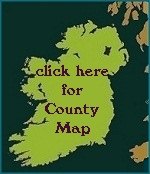
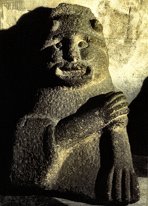

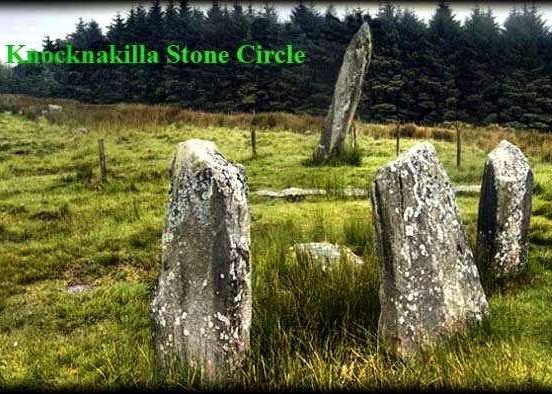
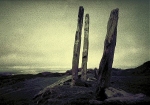

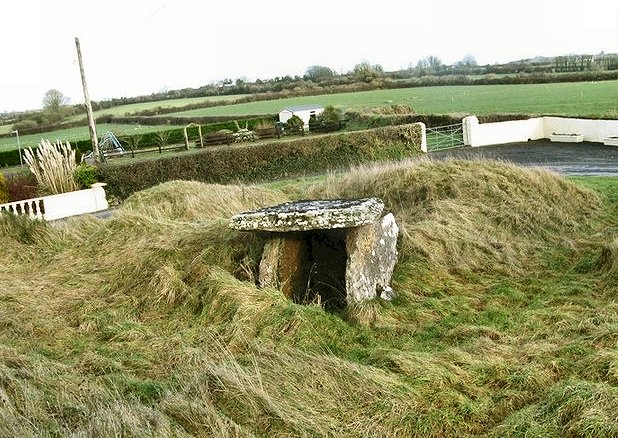 photo by Derek Ryan
photo by Derek Ryan
